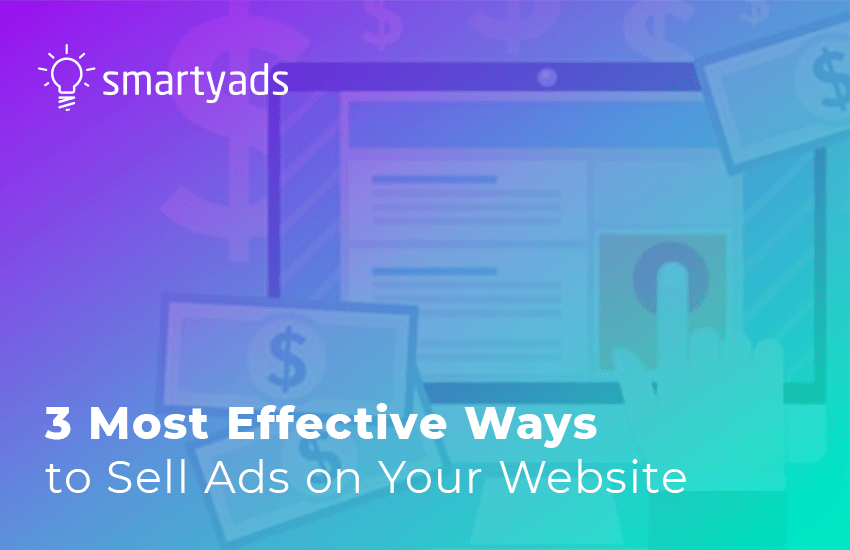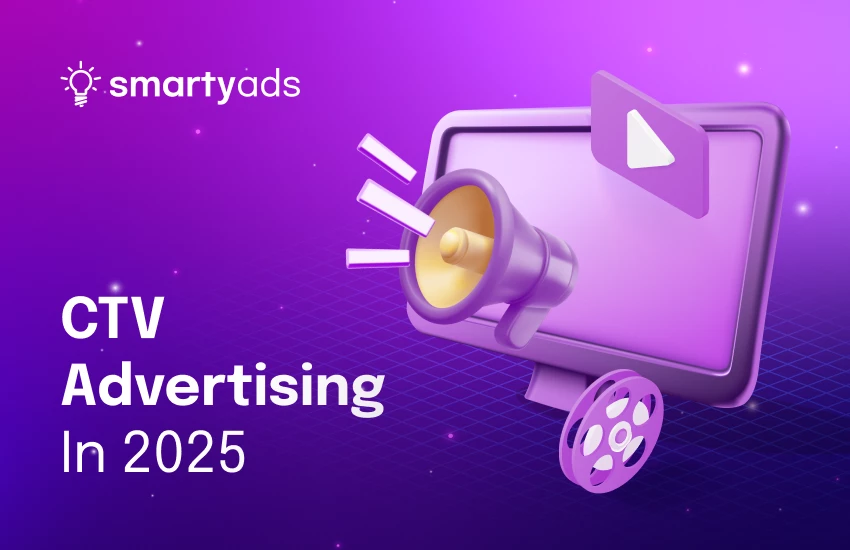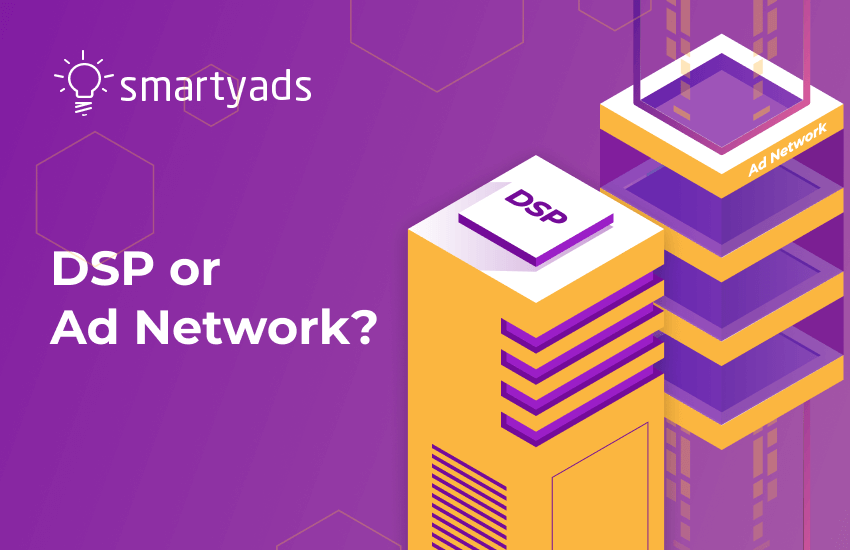These days, selling ad space isn’t what it used to be. Instead of negotiating deals over the phone or through direct sales, publishers now rely on data-driven systems that target specific audiences and sell impressions programmatically. This whole process happens within a connected ecosystem of ad tech platforms that encompass demand-side platforms, ad exchanges, ad networks, and supply-side platforms.
SSPs are where website owners or app developers come in. Think of them as the tech that helps publishers get the best deals for their ad space by connecting them with a range of advertisers. Instead of hoping for a buyer, publishers may use this technology to put their inventory in front of multiple bidding partners, increasing the chances of getting top dollar for every impression. If you’re looking to make your ad space work harder for you, learning how to use an SSP is a smart move so let’s get started!

What are Supply-Side Platforms (SSPs)?
Supply side platform SSP is a promotion software that publishers use to sell online advertising space, optimize it, and analyze the results. The supply side system has a dashboard with in-built publisher’s controls. They help to manage ad inventory (position, ad format, size, etc.), the price per impression, and other campaign details. As well, they allow media owner to extract the maximum value from every piece of available inventory as it is getting auctioned between advertisers in real-time. Read about 1st price vs 2nd price auction dynamic in our previous articles.
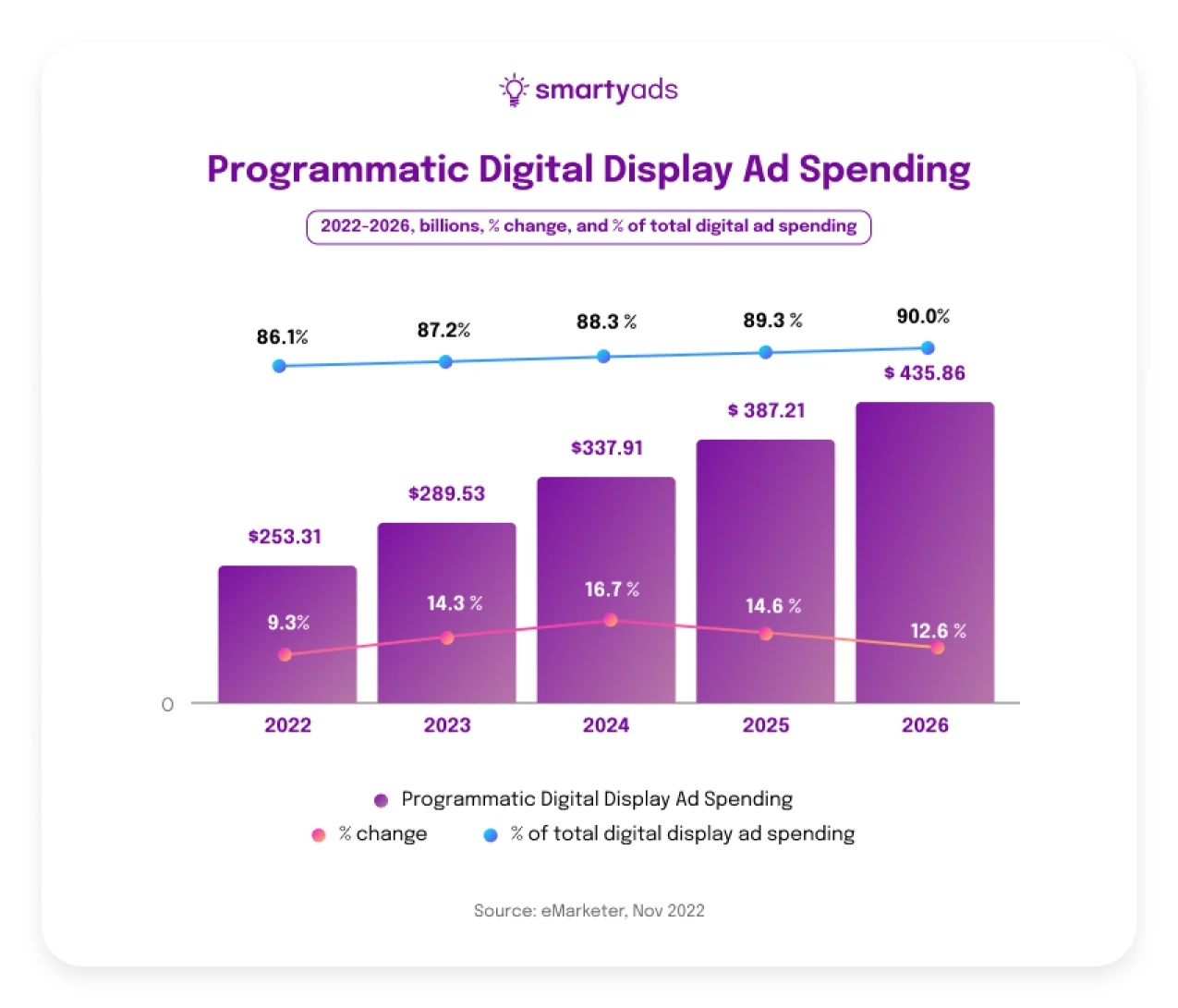
What is the difference between SSP and DSP?
There’s no such battle as SSP vs DSP. Sure the acronyms are very similar but these two perform completely different functions. SSP is an equivalent of the demand-side platform for advertisers but a supply-side platform is created for publishers. Using supply side technology like SSP, publishers can sell ad space to various DSPs and simultaneously offer it to a connected ad exchange, ad network, and all kinds of other RTB platforms.
They automate ad inventory filling, match publisher's requirements with offers, perform ad selection, and yield optimization. Just like advertisers configure campaigns in DSP dashboards, publishers configure the ad serving process in the dashboard of SSPs.
How do supply-side platforms work?
The supply-side platform is plugged into the programmatic ecosystem in order to sell ad impressions to the maximum number of potential buyers. As soon as the publisher configures the campaign setting the selling process is automated with programmatic or real-time bidding.
Then, SSP can automatically evaluate requirements, and send a request to DSPs or multiple ad exchanges. The ad exchange runs the auction and defines the highest bidding DSP. After this, ad exchange sends a signal to the ad server and the ad of the winner is getting served to the viewer.
Let’s see a detailed picture in order to understand how SSPs help media owners to manage inventory and sell ads. Here’s how SSPs are integrated into the programmatic ecosystem.
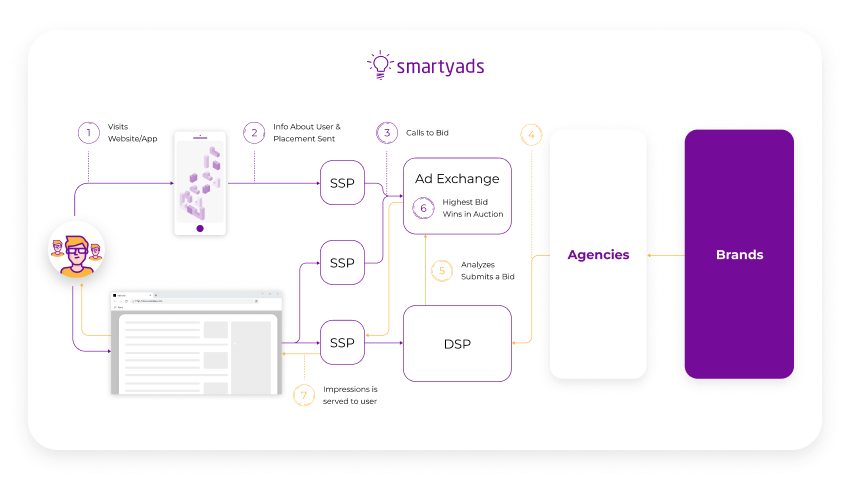
- As you can see in the picture, in order to serve ads to the users SSPs get integrated with the rest of the elements of the programmatic ecosystem like DSPs and ad exchanges. Each of these elements plays an important part in the ad serving process. Here’s how they interact:
- The user is opening a website or an app. While the web page or app is loading the cookies data is getting transmitted to the SSP. (Anonymized data types that enable user identification - geolocation, IP, OS, browser, etc.)
- The data about the available ad slot along with the data about the user is getting processed by SSP. SSP forms a request containing this information. As well such a request specifies the floor price - the minimum payment that the publisher is ready to accept for this impression.
- SSP calls to bid and sends a request towards DSPs.
- The DSP, in turn, analyzes the information contained in the request and defines whether the impression could be valuable to the advertiser or marketer (based on targeting, floor price, budget defined for the campaign, and other criteria).
- If the impression is relevant, DSP sends a bid response to the ad exchange where the auction takes place in real-time.
- An advertiser whose response has the highest bid wins in the auction and pays the price according to the second-price of the first-price auction model.
- The ad server (if any) or ad exchange sends the ad of the winner to the SSP and then the ad is served to the user. The entire process from website page opening to auctioning and ad serving takes milliseconds so that the user’s experience remains impeccable.
- Even though media-selling is totally automated, it entails no bad deal risk for publishers. For this, SSPs protect publisher’s yields with price floors. With this option, media owners specify the minimum price for which ad inventory can be sold. If the ad has suspicious content or spam, the publisher may lose the audience, however, the supply side solution deals with these risks as well. Website owners/app developers may choose which advertisers can bid on the inventory and which can’t. For this, they apply white and blacklists.
Why do you need SSP as a publisher?
Both publishers and advertisers are turning less to traditional media-trading. The media buying process has become fully automated, which saves time and reduces the internet promotion budget. Thus, we can see that advertisers have massively shifted to SSP in advertising together with publishers.
Before the advent of programmatic, website owners couldn't control the starting price of an impression. Thus the media cost was essentially determined by the advertisers. When SSPs came to the scene, this problem disappeared.
Through RTB it connects publishers to the worldwide pool of advertisers maximining the competition and removing the problem with inadequate pricing. As well, SSPs give website owners the opportunity to diversify pricing for their inventory to keep it profitable yet flexible enough to score more deals.
Advantages publishers get while using SSPs
Higher yields
The chance to reach as many advertisers as possible across the programmatic ecosystem - DSPs, exchanges, networks. A larger circle of potential buyers elevates the price of inventory.
Automation
As soon as publishers configure in the dashboard how they want their campaign to run, the system automates the ad serving. This means that placements are filled in real-time automatically, without manual actions.
Control over inventory
As a media owner, you can set up how you want the ads to be displayed on the website/in the app. Color, size, resolutions, formats, placement, allowed categories, floor prices - all this can be easily pre-selected by the publisher in the dashboard.
Reporting
Statistics that supply-side platforms generate for website owner can be eye-opening: who bids on inventory, what is a median bid and how each piece of inventory performs. The right metric can give publishers a real understanding of their inventory value.
Revenue optimization
You can set floor prices that adjust based on market needs, seasonality, or even specific ad formats. This way, you’re not leaving money on the table — your inventory gets priced right, every time.
Reputation management
Protecting your brand’s reputation is crucial. SSPs come with tools that let you block unwanted ad categories or specific advertisers, so you stay in control of what shows up on your site.
Simplicity and transparency
SSPs make it easy to keep an eye on your performance. The dashboard shows you exactly what’s going on — who’s bidding, what your top-performing placements are, and where the money’s coming from. It’s all right there, clear and straightforward.
Connection to multiple networks
The more networks you’re connected to, the more chances you have to sell your inventory. SSPs open the door to multiple DSPs, ad exchanges, and networks, bringing you more advertisers and better rates.

What features to look for in SSP?
Not all SSPs are equal, for sure. While you select the suitable media-selling technology it is important to pay close attention to your own needs, specifics of your visitors, and web source/app. There are a lot of ways to monetize website traffic, but advertising can generate the greatest income, especially if your traffic is sufficient and steady.
While some SSPs have no restrictions regarding the minimum traffic threshold, the others require media owner to meet certain criteria in order to be eligible for online ad serving. As soon as you know you can become a publisher at a certain supply-side platform, we recommend looking for the following features and characteristics.
Multiple Sources of Demand
It is important that an SSP is connected to as many DSPs and ad exchanges along with ad networks as possible. This maximizes reach meaning that impressions can potentially be served to more viewers. Premium advertisers can pay more money for the best quality inventory (read on a guide to website and blog traffic monetization). For this, SSP should also offer preferred and direct deals.
Greater competition forms a higher inventory price. That’s why SPSs also offer header bidding, real time bidding RTB, and SDK mediation. They provide fair purchasing conditions for advertisers and raise value per each inventory piece. Discover more about what is header bidding in our previous article.
The transparent system, granular reporting
Reports organize and visualize statistics to provide macro and micro insights into what works and what doesn’t. Also, reporting helps publishers to understand the true value of their digital inventory. Today, supply side platforms use Big Data analysis to make statistics in real-time.
A dashboard should provide information across all metrics that matter. For instance, the click-through rate (CTR) and the total number of clicks placement generates, fill rates, and so on.
Support for various ad formats
The more advertisement units your SSP is able to support - the better will be the result of monetization. Why? Because it means that all kinds of advertisers will be able to place ads on your inventory - both those who choose static ads and dynamic ads.
The other no less important benefit is that as a publisher you will be able to select among various digital ad formats - playable, rewarded, native ads, video ads, display video, push programmatic audio, and so on. This way you can choose which ad units to apply in order to achieve your unique purposes. Of course, the main purpose is yield but certain formats can also lead to higher in-app purchases, or better retention on-site/in-app (compared to others).
The header bidding or mediation
The header bidding and/or mediation give media owner the ability to maximize the pool of potential buyers. The tougher the competition will be, the higher price for ad slot publishers can charge. Header bidding is available for in-app, desktop, and mobile web environments. Instead of a traditional waterfall, this technology arranges a unified auction helping promoters bid on impressions at the same time, not in turns. Mediation technology enables publishers to send requests simultaneously to a large number of ad networks, which greatly increases the effectiveness of bidding..
Dynamic Price Floors
The price floor enables publishers to administer yield optimization in real-time. How does it happen? Ideally, website owners must establish “hard” and “soft” price floors and define a minimum acceptable cost per thousand impressions (CPM). It keeps pricing flexible enough to sell out remnant inventory to the last piece. Still, it protects the publisher from potentially disadvantageous deals because deals below a defined price threshold (price floor) won’t be allowed by the system.
Control over display
Alcohol, tobacco, or adult content can harm the reputation of the web source. Such ads can easily draw readers away. To prevent this, a system should have filters: both black and whitelists. They help publishers protect their inventory from unwanted displays and decide who they want to trade with. While choosing a new supply-side platform make sure that the publisher controls have the function to filter out certain unwanted categories of ads.
Brand safety
Brand safety and viewability are the two most important things that ad buyers want to guarantee for their campaigns. This means they want their ads to be served on websites and in apps that are characterized by good quality content that doesn’t damage the brand’s reputation. For this reason, in order to attract more brands, website owners should select SSP solutions that support inventory and seller authorization e.g., like ads.txt, ads.cert, and the rest of the IAB (Interactive Advertising Bureau) standards.
How to choose the right SSP for your website or app
Inventory reach
A good tool should connect you with a wide range of DSPs, ad exchanges, and direct ad buyers. The more demand partners you can access, the higher the competition for your inventory, which translates to better rates and increased revenue potential.
Reporting and analytics
Data is everything. Look for an SSP technology that provides clear, actionable insights through easy-to-read dashboards. Tracking metrics like CPM, fill rate, and bid activity helps you spot opportunities, identify weak spots, and make informed decisions to maximize earnings.
Revenue optimization tools
Dynamic pricing and floor price control are crucial features. They allow you to adjust rates based on demand, ensuring you’re not underselling valuable impressions. Advanced bid shading and algorithmic optimization can further boost your earnings without disrupting user experience.
Ad quality control
Maintaining brand integrity is key. Choose an SSP that lets you filter out unwanted advertisement categories and block specific advertisers. This keeps your content aligned with your brand values while ensuring a positive user experience.
Ease of use and customer support
Whether you prefer a managed service or a self-serve solution, the SSP should be easy to navigate. Intuitive interfaces save you time, and responsive support can be a lifesaver when you need quick fixes or guidance.
The future of SSPs
Technologies are evolving fast, and staying ahead of the curve means knowing what’s coming next. Here are some trends to keep an eye on:
Advanced AI and machine learning
Solutions are getting smarter. Expect more AI-driven algorithms that can predict optimal pricing, identify valuable audiences, and adjust bids in real time. This means website owners can squeeze more revenue out of every impression without lifting a finger.
Unified auction models
First-price auctions are here to stay, but SSPs are also testing hybrid and dynamic auction models. The goal? To maximize publisher revenue by optimizing how bids are evaluated and accepted, making every impression count.
CTV and video monetization
With video and connected TV (CTV) advertisements skyrocketing, systems are doubling down on these formats. Advanced targeting and interactive ad units will be game-changers, allowing publishers to tap into high-CPM inventory while delivering more engaging experiences.
Privacy-first targeting
As privacy regulations tighten, SSPs are leaning into privacy-first solutions. Expect more contextual targeting, first-party data integration, and cookieless identifiers that respect user privacy while still delivering relevant SSP ads.
Sustainability and green marketing
Sustainability is becoming a bigger focus in ad tech. Businesses are starting to prioritize green advertisement practices, reducing data transfer and optimizing energy use to minimize the environmental impact of SSP advertising.
Programmatic audio and podcasts
As podcasting continues to grow, SSPs are expanding into programmatic audio. This opens up new revenue streams for website owners who can integrate audio ad slots alongside their existing display and video inventory.
Supply path optimization (SPO)
The days of blindly connecting to every demand source are over. Techs are now focusing on supply path optimization, cutting out low-quality or redundant partners to deliver more transparent, cost-effective advertisement transactions.
What’s the conclusion?
Programmatic advertising has opened the door for anyone to step into the world of digital markeing — whether you’re running a blog, managing an online store, or simply owning a website with a steady stream of visitors. If you’ve got valuable content and traffic, there’s a good chance you can turn that into revenue.
The best part? Using a supply-side platform doesn’t have to be complicated. With managed SSP services, you can let the pros handle everything while you learn the ropes. And once you’re ready, you can take control and run your inventory independently.
Whether you choose managed or self-serve, SmartyAds SSP is built to connect you with a wider pool of advertisers, boosting your revenue potential and enhancing user experience.
Ready to level up your monetization game? Let SmartyAds SSP do the heavy lifting.

.webp)
